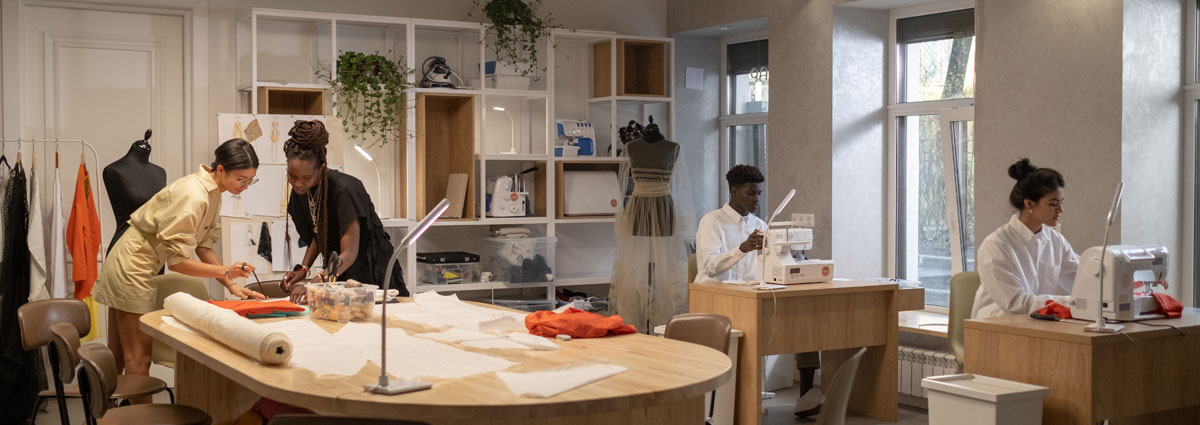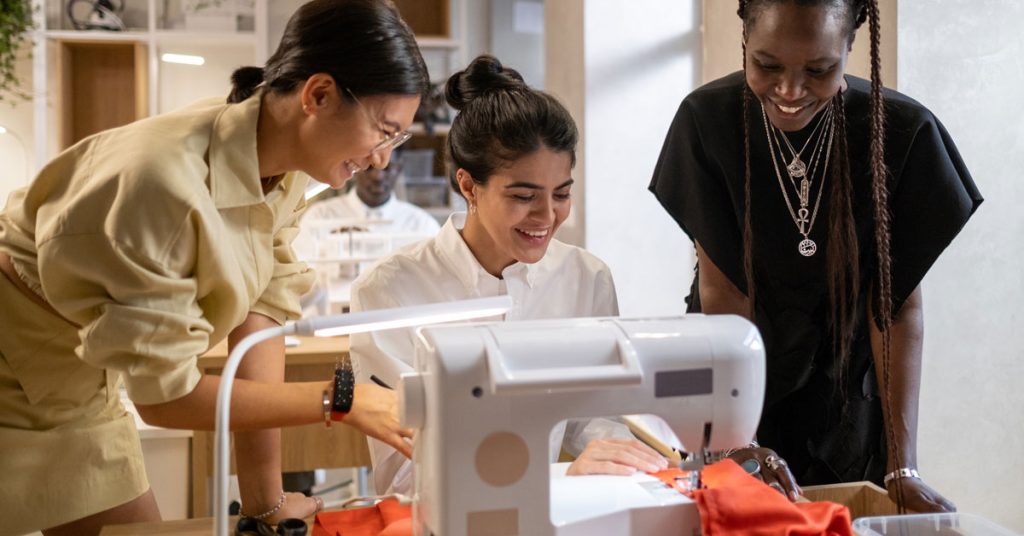Exploring the World of Computerized vs. Mechanical Sewing Machines…
Ever found yourself at the crossroads of choosing between a computerized sewing machine and a mechanical sewing machine? For a beginner or even an experienced sewer, making this decision can be daunting. After all, both machines have their unique strengths. But don’t fret! By the end of this guide, you’ll have a crystal-clear understanding of both types.
So, which machine best fits your sewing aspirations: computerized or mechanical sewing machine? Let’s dive into the world of sewing and unravel this mystery together!
Comparison table of Computerized vs. Mechanical Sewing Machines
| Feature/Aspect | Mechanical Sewing Machines | Computerized Sewing Machines |
|---|---|---|
| Images |  |  |
| Basic Overview | Traditional machines operated manually using dials, levers, and knobs. | Modern machines are equipped with a microprocessor, offering touchscreens and automated features. |
| Stitch Versatility | Limited to basic stitches like straight, zigzag, and a few decorative ones. | Expansive range, from basic to advanced decorative stitches. Some allow custom stitch pattern downloads. |
| Ease of Use | Requires a hands-on approach with manual adjustments. | Intuitive user interface with touchscreens and push-button operations. Built-in tutorials are available. |
| Durability & Maintenance | Robust and can last decades with regular oiling and occasional tension adjustments. | Sturdy but may be sensitive to dust and mishandling. Might require software updates. |
| Price Point | Generally more affordable, and great for beginners or those on a budget. | Tend to be pricier due to advanced features. An investment for serious sewing enthusiasts. |
| Ideal For | Beginners, hobbyists, and those who appreciate manual control and a vintage feel. | Professionals, design students, and those looking for intricate patterns and advanced sewing capabilities. |
| Learning Curve | Steeper learning curve as users manually adjust settings, but this can be beneficial for foundational learning. | Easier learning curve due to automated features, but may require familiarization with digital components. |
| Customization & Innovation | Limited to the built-in features of the machine. No digital customizations. | Allows for vast customization, including downloading new patterns or even creating unique stitch designs. |
| Portability | Often heavier and bulkier due to metal construction. | Can be lighter and more compact, but this varies by model. |
| Power Source | Primarily mechanical components powered by manual operations or a basic electric motor. | Requires electricity, especially for the digital components and features. |
| Backup & Storage | Not applicable since there’s no digital component. | Some models offer memory storage for patterns, settings, and custom designs. Backup might be possible via USB or cloud. |
| Startup Time | Almost instantaneous. Just turn it on and start sewing. | Might require a short boot-up time, especially for those with extensive digital features. |
| Attachment Compatibility | Can work with basic attachments, like different foot types. | Often compatible with advanced attachments, and some can calibrate themselves according to the attachment used. |
| Environmental Sensitivity | Less sensitive to environmental factors, but care should be taken to avoid rust. | Sensitive to extreme temperatures or humidity, which might affect the digital components. |
| Repair & Servicing | Repairs might be simpler and can often be done by seasoned sewers themselves. Parts might be more universally available. | Repairs, especially of digital components, might require specialized service. Some parts might be model-specific. |
| Feedback Mechanism | No feedback except tactile and auditory feedback from the machine’s operation. | Provides visual and auditory alerts, warnings, or feedback on the touchscreen or through sounds. |
| Regular Updates | No updates are required. The machine remains static in its functionality. | Some models might offer firmware or software updates to improve functionality or fix bugs. |
| Workspace Lighting | Usually equipped with a single basic light bulb to illuminate the workspace. | Often come with brighter, sometimes LED, lights. Some models might offer adjustable lighting. |
| Automatic Features | Limited to basic functions like automatic bobbin winding. | Numerous, including automatic thread cutting, needle threading, tension setting, and more. |
| Energy Consumption | Generally consumes less energy due to fewer electronic components. | Might consume more power, especially when utilizing advanced features or when left on for extended periods. |
Core Differences: What is the difference between Computerized and Mechanical sewing machines?
A. The Machine’s Heartbeat: A Basic Overview
Mechanical Sewing Machines: Think of these as the classics of the sewing world. Evoking a sense of nostalgia, mechanical machines operate primarily through dials, levers, and knobs. Devoid of modern electronic frills, they provide an authentic and direct sewing experience. Their straightforward nature and rugged build make them a perennial favorite for many who seek reliability.
Computerized Sewing Machines: Entering the digital age, these machines are the tech-savvy cousins in the sewing family. A built-in microprocessor powers their operations. With features such as touchscreens and pattern storage capacities, they cater to those who relish precision and variety in their projects. For those looking to craft intricate designs or undertake advanced sewing ventures, these machines promise a world of innovation.
B. Stitching Stories: From Simple Classics to Diverse Possibilities
Mechanical Machines: They offer the core stitch types – straight, zigzag, and a handful of decorative stitches. There’s an elegant simplicity to these machines. They remind you of the age-old saying, “Less is more.” Their limited stitch repertoire emphasizes mastering foundational sewing techniques.
Computerized Machines: These are the Swiss army knives in the realm of stitching. Not only do they provide a plethora of stitch types, ranging from basic to highly decorative, but some models also offer the luxury of downloading or even designing custom stitch patterns. This allows for boundless creativity, making each sewing project uniquely yours.
C. User Experience: Navigating Manual Controls vs. Digital Interfaces
Mechanical Machines: Operating these machines is a tactile journey. Turning dials and adjusting settings manually gives sewers a tangible connection to their craft. It’s perfect for those who appreciate hands-on control and the satisfaction that comes from manually fine-tuning their work.
Computerized Machines: These are designed for intuitive use. Their touchscreens and button operations simplify the sewing process, making it accessible to both novices and seasoned sewers. Many models are equipped with built-in tutorials and handy tips, acting as a digital assistant throughout your sewing adventure.
D. Durability Quotient: Vintage Charm vs. Contemporary Elegance
Mechanical Machines: Often heralded as the workhorses of the sewing world, these machines boast impressive longevity. With a sturdy build, they’re known to stand the test of ti
me. Routine maintenance like periodic oiling and tension checks keeps them running smoothly, often for decades.Computerized Machines: While they possess a robust build, their digital components can be sensitive. Dust can be a nemesis, so they often need a tad more TLC. And just like our smartphones and computers, periodic software updates ensure they function at their best.
Read More: Are computerized sewing machines better than manual ones in speed and efficiency?
E. Financial Considerations: Pocket-Friendly vs. Premium Investment
Mechanical Machines: Typically, these machines are gentler on the wallet. For those just dipping their toes into working within a budget, mechanical machines offer great value without compromising on essential features.
Check the Latest Prices on Amazon
Computerized Machines: Higher price tags accompany the advanced features they offer. Their diverse functionalities and precision tools make them worth the investment, especially for those committed to elevating their sewing prowess. Think of them as a long-term investment in your creative journey.
Check the Latest Prices on Amazon
Making Your Choice: Which Machine Suits Whom?
Mechanical Machines: The Traditionalists’ Choice

If you’re someone just beginning to navigate the intricate world of sewing, a mechanical or non-computerized machine might be your best companion.
Why? Here’s a breakdown:
- Foundational Learning: Mechanical machines offer a more hands-on experience. For beginners, this means understanding the very essence of sewing from the ground up. The process of manually selecting stitches and adjusting tensions can be invaluable in mastering the basics.
- Hobbyist Haven: For those who sew occasionally, maybe to mend a tear, adjust a hem, or create the occasional DIY project, a mechanical machine provides all the necessary features without overwhelming options.
- Vintage Vibes: There’s a certain charm in the analog nature of mechanical machines. For many, the act of turning dials and hearing the rhythmic hum of the machine is therapeutic. If you’re someone who cherishes this nostalgic feel, a mechanical machine is like a trip down memory lane every time you sew.
- Control Enthusiasts: The tactile feedback of manual adjustments can be satisfying. If you’re someone who loves to have granular control over your sewing sessions, these machines offer just that.
Computerized Machines: The Modern Maven’s Dream

Are you a sewing enthusiast with an appetite for innovation, precision, and variety? Or perhaps a professional whose livelihood depends on producing impeccable work?
Here’s why a computerized machine might be your match:
- Precision Tailored: The hallmark of computerized machines is their precision. They offer consistent stitch quality, tension adjustments, and more, making them ideal for projects where every stitch counts.
- Boundless Creativity: With a myriad of built-in stitches and the ability to download or even create custom patterns, the sky’s the limit. Design students or creatives looking to push the boundaries of conventional sewing will find this feature indispensable.
- Time Efficiency: Professionals, especially those handling bulk orders or intricate designs, will appreciate the automated features. Features like automatic needle threading, thread cutting, and pattern memory can significantly speed up projects.
- User-Friendly Interface: For those wary of complex setups or extensive manuals, computerized machines often come equipped with intuitive touchscreens. Quick tutorials, digital displays showing stitch settings, and other user-centric features make the sewing journey smoother.
Related: Electronic vs Computerized Sewing Machines
Stitching it All Together Mechanical Sewing machine vs Computerized
Choosing between a computerized and a mechanical sewing machine boils down to your sewing goals, budget, and personal preference. If you’re a purist who enjoys the tactile nature of sewing, a mechanical machine will serve you well.
But if you’re looking to experiment, innovate, and push the boundaries of what’s possible with a sewing machine, then a computerized one might just be your perfect companion.
Remember, the best sewing machine is the one that meets your needs and helps bring your creative visions to life.
Photo: Amazon





